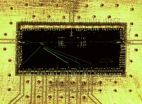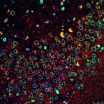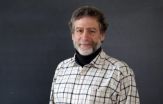(Press-News.org) In a key step toward creating a working quantum computer, Princeton researchers have developed a method that may allow the quick and reliable transfer of quantum information throughout a computing device
The finding, by a team led by Princeton physicist Jason Petta, could eventually allow engineers to build quantum computers consisting of millions of quantum bits, or qubits. So far, quantum researchers have only been able to manipulate small numbers of qubits, not enough for a practical machine.
"The whole game at this point in quantum computing is trying to build a larger system," said Andrew Houck, an assistant professor of electrical engineering who is part of the research team.
To make the transfer, Petta's team used a stream of microwave photons to analyze a pair of electrons trapped in a tiny cage called a quantum dot. The "spin state" of the electrons – information about how they are spinning - serves as the qubit, a basic unit of information. The microwave stream allows the scientists to read that information.
"We create a cavity with mirrors on both ends – but they don't reflect visible light, they reflect microwave radiation," Petta said. "Then we send microwaves in one end, and we look at the microwaves as they come out the other end. The microwaves are affected by the spin states of the electrons in the cavity, and we can read that change."
In an ordinary sense, the distances involved are very small; the entire apparatus operates over a little more than a centimeter. But on the subatomic scale, they are vast. It is like coordinating the motion of a top spinning on the moon with another on the surface of the earth.
"It's the most amazing thing," said Jake Taylor, a physicist at the National Institute of Standards and Technology and the Joint Quantum Institute at the University of Maryland, who worked on the project with the Princeton team. "You have a single electron almost completely changing the properties of an inch-long electrical system."
For years, teams of scientists have pursued the idea of using quantum mechanics to build a new machine that would revolutionize computing. The goal is not build a faster or more powerful computer, but to build one that approaches problems in a completely different fashion.
Standard computers store information as classical "bits", which can take on a value of either 0 or 1. These bits allow programmers to create the complex instructions that are the basis for modern computing power. Since Alan Turing took the first steps toward creating a computer at Princeton in 1936, engineers have created vastly more powerful and complex machines, but this basic binary system has remained unchanged.
The power of a quantum computer comes from the strange rules of quantum mechanics, which describe the universe of subatomic particles. Quantum mechanics says that an electron can spin in one direction, representing a 1, or in another direction, a 0. But it can also be in something called "superposition" representing all states between 1 and 0. If scientists and engineers can build a working machine that takes advantage of this, they would open up entirely new fields of computing.
"The point of a quantum computer is not that they can do what a normal computer can do but faster; that's not what they are," said Houck. "The quantum computer would allow us to approach problems differently. It would allow us to solve problems that cannot be solved with a normal computer."
Mathematicians are still working on possible uses for a quantum system, but the machines could allow them to accomplish tasks such as factoring currently unfactorable numbers, breaking codes or predicting the behavior of molecules.
One challenge facing scientists is that the spins of electrons, or any other quantum particles, are incredibly delicate. Any outside influences, whether a wisp of magnetism or glimpse of light, destabilizes the electrons' spins and introduces errors.
Over the years, scientists have developed techniques to observe spin states without disturbing them. (This year's Nobel Prize in physics honored two scientists who first demonstrated the direct observation of quantum particles.) But analyzing small numbers of spins is not enough; millions will be required to make a real quantum processor.
To approach the problem, Petta's team combined techniques from two branches of science: from materials science, they used a structure called a quantum dot to hold and analyze electrons' spins; and from optics, they adopted a microwave channel to transfer the spin information from the dot.
To make the quantum dots, the team isolated a pair of electrons on a small section of material called a "semiconductor nanowire." Basically, that means a wire that is so thin that it can hold electrons like soda bubbles in a straw. They then created small "cages" along the wire. The cages are set up so that electrons will settle into a particular cage depending on their energy level.
This is how the team reads the spin state: electrons of similar spin will repel, while those of different spins will attract. So the team manipulates the electrons to a certain energy level and then reads their position. If they are in the same cage, they are spinning differently; if they are in different cages, the spins are the same.
The second step is to place this quantum dot inside the microwave channel. This allows the team to transfer the information about the pair's spin state – the qubit.
Petta said the next step is to increase the reliability of the setup for a single electron pair. After that, the team plans to add more quantum dots to create more qubits. Team members are cautiously optimistic. There appear to be no insurmountable problems at this point but, as with any system, increasing complexity could lead to unforeseen difficulties.
"The methods we are using here are scalable, and we would like to use them in a larger system," Petta said. "But to make use of the scaling, it needs to work a little better. The first step is to make better mirrors for the microwave cavity."
INFORMATION:
The research was reported in the journal Nature on Oct. 18. In addition to Petta, Houck and Taylor, the research team includes associate research scholar Karl Petersson, undergraduate student Louis McFaul, post-doctoral researcher Minkyung Jung and graduate student Michael Schroer of the Princeton physics department.
Support for the research was provided by the National Science Foundation, the Alfred P. Sloan Foundation, the Packard Foundation, the Army Research Office, and the Defense Advanced Research Projects Agency Quantum Entanglement Science and Technology Program.
Breakthrough offers new route to large-scale quantum computing
2012-10-20
ELSE PRESS RELEASES FROM THIS DATE:
Take control! Exploring how self-discipline works and how we might boost it
2012-10-20
Converging scientific evidence – not to mention a great deal of life experience – tells us that self-control is an important ability. It helps us keep our cool, get things done, and resist the things that tempt us. Scientists believe that gaining a clearer understanding of how self-control works could provide critical insights into addressing some of the large-scale problems facing society today, including obesity and addiction.
Numerous studies have found evidence for the idea of self-control as a limited resource, but emerging research suggests that this model may not ...
Salk scientists pinpoint key player in Parkinson's disease neuron loss
2012-10-20
LA JOLLA, CA---- By reprogramming skin cells from Parkinson's disease patients with a known genetic mutation, researchers at the Salk Institute for Biological Studies have identified damage to neural stem cells as a powerful player in the disease. The findings, reported online October 17th in Nature, may lead to new ways to diagnose and treat the disease.
The scientists found that a common mutation to a gene that produce the enzyme LRRK2, which is responsible for both familial and sporadic cases of Parkinson's disease, deforms the membrane surrounding the nucleus of a ...
Daily vibration may combat prediabetes in youth
2012-10-20
AUGUSTA, Ga. – Daily sessions of whole-body vibration may combat prediabetes in adolescents, dramatically reducing inflammation, average blood glucose levels and symptoms such as frequent urination, researchers report.
In mice that mimic over-eating adolescents headed toward diabetes, 20 minutes of daily vibration for eight weeks restored a healthy balance of key pro- and anti-inflammatory mediators and was better than prescription drugs at reducing levels of hemoglobin A1c, the most accurate indicator of average blood glucose levels, said Dr. Jack C. Yu, Chief of the ...
Disk galaxies formed gradually, astronomers find from images, computer simulations, and spectra
2012-10-20
Spectroscopic observations of distant galaxies taken with the 10-meter telescopes at the W. M. Keck Observatory on Hawaii, when combined with images taken by the Hubble Space Telescope plus supercomputer simulations to help interpret the observations, together reveal a major surprise: that a standard assumption about the evolution of galaxies is not correct.
Astronomers had thought that disk galaxies (like our own Milky Way) had largely finished forming by about 8 billion years ago, as indicated by the rates at which stars are formed in the Universe. Therefore, many astronomers ...
Science reveals the power of a handshake
2012-10-20
New neuroscience research is confirming an old adage about the power of a handshake: strangers do form a better impression of those who proffer their hand in greeting.
A firm, friendly handshake has long been recommended in the business world as a way to make a good first impression, and the greeting is thought to date to ancient times as a way of showing a stranger you had no weapons. Now, a paper published online and for the December print issue of the Journal of Cognitive Neuroscience on a study of the neural correlates of a handshake is giving insight into just ...
Dartmouth researchers explore how the brain perceives direction and location
2012-10-20
The Who asked "who are you?" but Dartmouth neurobiologist Jeffrey Taube asks "where are you?" and "where are you going?" Taube is not asking philosophical or theological questions. Rather, he is investigating nerve cells in the brain that function in establishing one's location and direction.
Taube, a professor in the Department of Psychological and Brain Sciences, is using microelectrodes to record the activity of cells in a rat's brain that make possible spatial navigation—how the rat gets from one place to another—from "here" to "there." But before embarking to go ...
NASA sees extra-large, now extra-tropical storm Prapiroon fading
2012-10-20
Prapiroon is both extra-large and now extra-tropical in the western North Pacific Ocean. NASA's Terra satellite captured an image of the large storm after Prapiroon became extra-tropical.
The Moderate Resolution Imaging Spectroradiometer (MODIS) instrument aboard NASA's Terra satellite captured a visible image of Extra-tropical Storm Prapiroon on Oct. 19 at 01:15 UTC (Oct. 18, 9:15 p.m. EDT). The storm appeared on the MODIS image to be as large as the main island of Japan and the strongest thunderstorms and heaviest rainfall appeared north of the center of circulation ...
Astronomers uncover a surprising trend in galaxy evolution
2012-10-20
VIDEO:
A study of 544 star-forming galaxies observed by the Keck and Hubble telescopes shows that disk galaxies like our own Milky Way unexpectedly reached their current state long after much...
Click here for more information.
A comprehensive study of hundreds of galaxies observed by the Keck telescopes in Hawaii and NASA's Hubble Space Telescope has revealed an unexpected pattern of change that extends back 8 billion years, or more than half the age of the universe.
"Astronomers ...
Cholera discovery could revolutionize antibiotic delivery
2012-10-20
Contact:
Lisa Craig (Burnaby resident), 778.782.7140, licraig@sfu.ca
Carol Thorbes, PAMR, 778.782.3035, cthorbes@sfu.ca
Photos on Flickr: http://at.sfu.ca/lutURE END ...
RIT professor studies connection between child, mother mortality
2012-10-20
The death of a child is a tragic event for a family, bringing with it feelings of numbness, anger, guilt and denial. And, unfortunately, for many families, the loss becomes too much to bear.
A new study co-conducted by a researcher at Rochester Institute of Technology uncovers the strong connection between the death of a child and the mortality of the mother, regardless of cause of death, gender of the child, marital status, family size, income or education level of the mother.
Javier Espinosa, assistant professor in RIT's College of Liberal Arts and an expert in health ...




